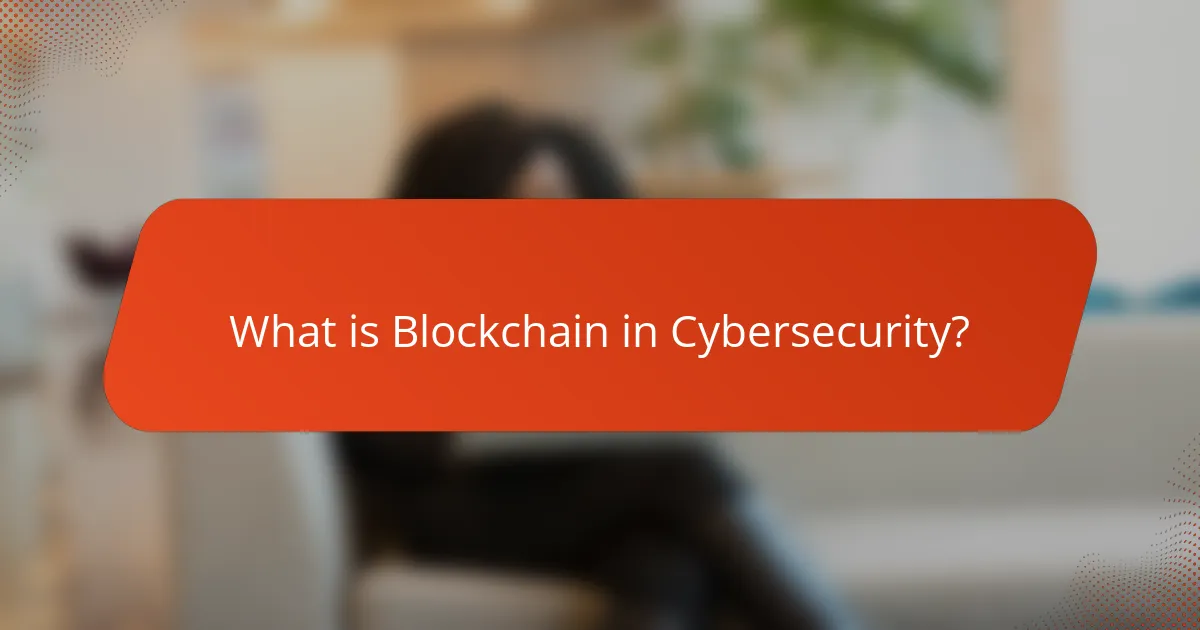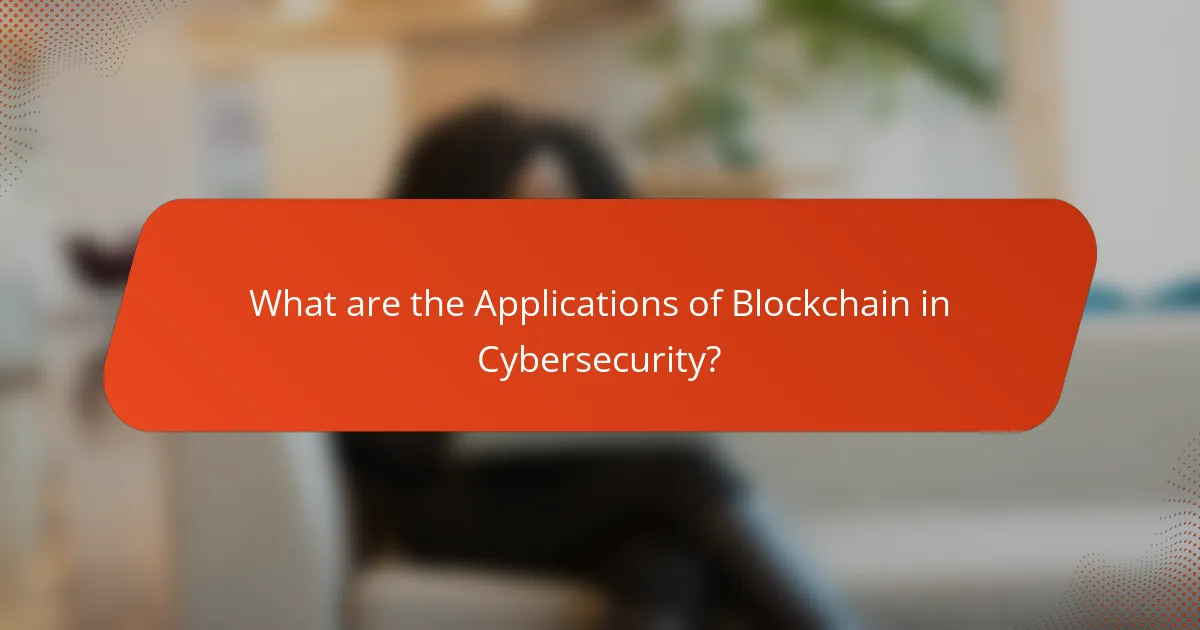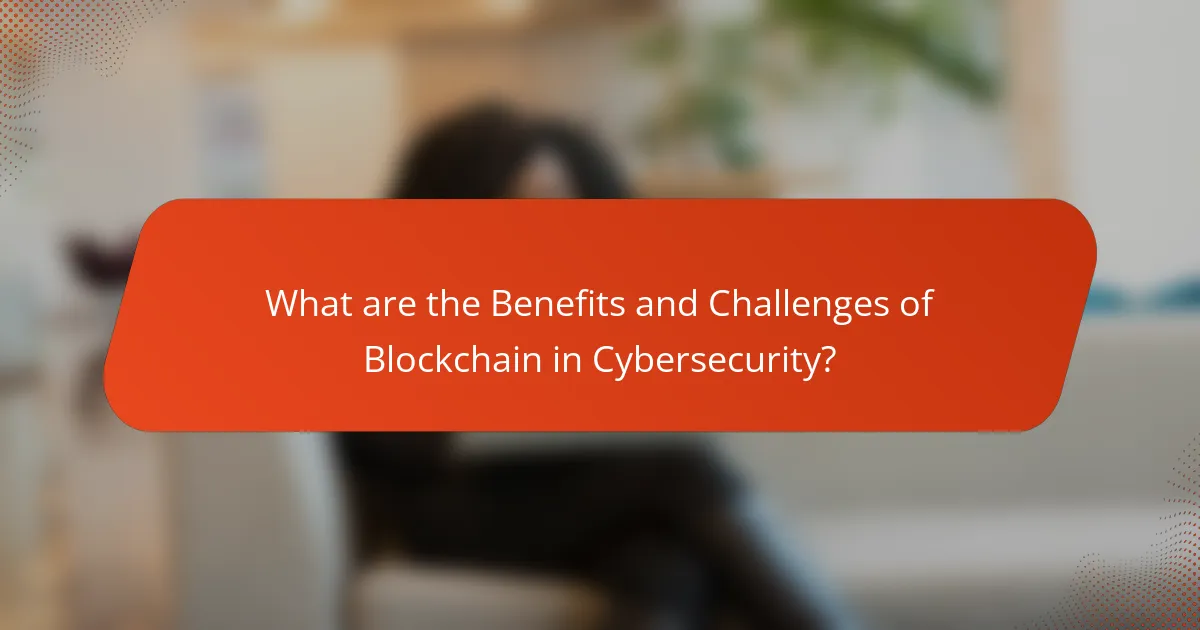Blockchain is a decentralized digital ledger technology that significantly enhances cybersecurity by ensuring data integrity and security. It records transactions across multiple computers, making unauthorized access and data tampering highly challenging. This article explores the applications of blockchain in cybersecurity, including its role in identity management, secure transactions, and smart contracts. It also discusses the benefits of blockchain, such as improved data security and transparency, while addressing challenges like scalability, interoperability, and regulatory uncertainties. Overall, blockchain presents a promising framework for bolstering cybersecurity measures in various organizations.

What is Blockchain in Cybersecurity?
Blockchain in cybersecurity is a decentralized digital ledger technology that enhances data security. It records transactions across multiple computers, ensuring that the data cannot be altered retroactively. Each block in the chain contains a cryptographic hash of the previous block, creating a secure link. This structure makes unauthorized access and data tampering extremely difficult. Blockchain’s transparency allows for real-time auditing and monitoring of data integrity. According to a report by Deloitte, 40% of organizations are exploring blockchain for cybersecurity applications. Its use in identity management and secure transactions further illustrates its potential in protecting sensitive information.
How does Blockchain technology enhance cybersecurity?
Blockchain technology enhances cybersecurity by providing decentralized and tamper-proof data storage. Each transaction in a blockchain is recorded in a block and linked to previous blocks. This structure makes it extremely difficult for hackers to alter data without detection. The use of cryptographic hashing secures the integrity of the data. According to a report by IBM, blockchain can reduce the risk of data breaches by 80%. Additionally, blockchain’s transparency allows for real-time auditing and monitoring of data access. This further strengthens security protocols and ensures accountability. Overall, blockchain’s unique features significantly improve cybersecurity measures.
What are the key features of Blockchain that support cybersecurity?
Blockchain supports cybersecurity through decentralization, immutability, transparency, and cryptographic security. Decentralization reduces single points of failure. This makes it harder for attackers to compromise the system. Immutability ensures that once data is recorded, it cannot be altered. This protects against data tampering and unauthorized changes. Transparency allows all participants to view transactions. This visibility helps to detect fraudulent activities quickly. Cryptographic security safeguards data through encryption. This ensures that only authorized users can access sensitive information. Together, these features create a robust framework for enhancing cybersecurity measures.
How does decentralization in Blockchain improve security?
Decentralization in blockchain improves security by distributing data across multiple nodes. This distribution makes it difficult for a single point of failure to compromise the entire system. Each node maintains a copy of the entire blockchain, enhancing data integrity. If one node is attacked or fails, others continue to operate normally. Additionally, consensus mechanisms, such as Proof of Work or Proof of Stake, require agreement among nodes before changes are made. This prevents unauthorized alterations to the blockchain. According to a 2020 report by the World Economic Forum, decentralized systems significantly reduce the risk of data breaches. The decentralized nature also makes it challenging for malicious actors to manipulate the data.
Why is Blockchain considered a game-changer in cybersecurity?
Blockchain is considered a game-changer in cybersecurity due to its decentralized nature. This decentralization reduces the risk of single points of failure. Each transaction is recorded on a distributed ledger, making data tampering extremely difficult. The use of cryptographic techniques ensures that data integrity is maintained. Blockchain’s transparency allows for real-time auditing and monitoring of transactions. According to a report by IBM, 40% of organizations believe blockchain can enhance their cybersecurity posture. This technology also facilitates secure identity verification, reducing the chances of identity theft. Overall, blockchain provides robust security features that traditional systems struggle to offer.
What traditional cybersecurity challenges does Blockchain address?
Blockchain addresses several traditional cybersecurity challenges. It enhances data integrity by ensuring that once data is recorded, it cannot be altered without consensus. This immutability protects against data tampering and unauthorized changes. Blockchain also provides decentralized storage, reducing the risk of single points of failure. This decentralization makes it harder for attackers to compromise the entire system. Additionally, blockchain enhances transparency through its public ledger, allowing for better tracking of transactions. This visibility can help in auditing and compliance efforts. Furthermore, blockchain utilizes cryptographic techniques for secure transactions, significantly reducing the risk of fraud. These features collectively address issues like data breaches, identity theft, and unauthorized access effectively.
How does Blockchain mitigate risks associated with data breaches?
Blockchain mitigates risks associated with data breaches through its decentralized and immutable nature. By distributing data across multiple nodes, blockchain eliminates single points of failure. This reduces the likelihood of unauthorized access or data manipulation. Each transaction is encrypted and linked to the previous one, enhancing security. Additionally, blockchain provides transparency, allowing for real-time monitoring of data changes. This visibility helps in detecting anomalies quickly. Smart contracts can automate access control, ensuring only authorized users interact with sensitive data. According to a 2020 study by IBM, organizations using blockchain reported a 30% reduction in data breach incidents.

What are the Applications of Blockchain in Cybersecurity?
Blockchain technology has several applications in cybersecurity. It enhances data integrity through decentralized ledgers. This means that once data is recorded, it cannot be altered without consensus from the network. Blockchain also improves authentication processes. It uses cryptographic methods to verify identities securely. Furthermore, it can facilitate secure data sharing among organizations. This reduces the risk of data breaches. Additionally, blockchain supports smart contracts that automate security protocols. These contracts execute automatically when predefined conditions are met. Overall, blockchain provides a robust framework for enhancing cybersecurity measures.
How is Blockchain utilized in identity management?
Blockchain is utilized in identity management by providing a decentralized and secure method for verifying identities. This technology allows individuals to control their own identity data. Blockchain’s immutable ledger ensures that identity information cannot be altered without consensus. It enhances security by reducing the risk of data breaches common in centralized systems. Companies like Evernym have implemented blockchain for self-sovereign identity solutions. These systems allow users to share only necessary information with service providers. According to a report by the World Economic Forum, blockchain can reduce identity fraud significantly. This application of blockchain in identity management is gaining traction across various sectors.
What benefits does Blockchain provide for identity verification?
Blockchain enhances identity verification by providing a secure and decentralized method of storing identity data. It ensures data integrity through cryptographic hashing. This prevents unauthorized alterations and fraud. Blockchain allows individuals to control their own identity information. Users can share only necessary data without revealing full identities. The transparency of blockchain enables easier auditing of identity transactions. This builds trust among parties involved in the verification process. According to a 2020 report by the World Economic Forum, blockchain can reduce identity fraud by up to 80%. This highlights its effectiveness in enhancing security and reliability in identity verification.
How does Blockchain prevent identity theft?
Blockchain prevents identity theft by providing a decentralized and immutable ledger for storing identity information. Each transaction on the blockchain is recorded in a way that is secure and transparent. This means that once data is entered, it cannot be altered or deleted without consensus from the network.
Additionally, blockchain utilizes cryptographic techniques to protect data. Users have control over their private keys, which are necessary to access their information. This ensures that only authorized individuals can access or modify their identity data.
The transparency of blockchain allows for real-time verification of identities, making it harder for fraudulent activities to occur. According to a study by the World Economic Forum, blockchain technology can significantly reduce identity theft by enhancing security measures.
In what ways does Blockchain enhance data integrity?
Blockchain enhances data integrity by providing a decentralized and immutable ledger system. Each transaction is recorded in a block and linked to previous blocks. This creates a chain of data that is secure from tampering. Once data is added to the blockchain, it cannot be altered without consensus from the network. This consensus mechanism ensures that all participants agree on the validity of the data. Additionally, blockchain employs cryptographic techniques to secure data entries. Each block contains a unique hash that changes if the data is modified. This makes unauthorized changes easily detectable. Moreover, the transparency of blockchain allows for real-time verification of data integrity by all participants.
How does Blockchain ensure data authenticity?
Blockchain ensures data authenticity through its decentralized and immutable ledger system. Each transaction is recorded in a block and linked to the previous block, forming a chain. This structure prevents any alteration of data once it is added. Each block contains a cryptographic hash of the previous block, ensuring integrity. The decentralized nature means no single entity controls the data. This reduces the risk of tampering or fraud. Additionally, consensus mechanisms validate transactions before they are added to the blockchain. These mechanisms require agreement from multiple participants, enhancing trust. According to a report by the World Economic Forum, blockchain technology can significantly reduce data breaches by providing transparent and secure data management.
What role does Blockchain play in secure data sharing?
Blockchain provides a decentralized and transparent framework for secure data sharing. It ensures that data is immutable, meaning once recorded, it cannot be altered. Each transaction is encrypted and linked to the previous one, forming a secure chain. This structure enhances trust among parties sharing data. Additionally, blockchain allows for controlled access through cryptographic keys. Only authorized users can view or modify the data. This significantly reduces the risk of data breaches. According to a study by IBM, 77% of organizations believe blockchain will enhance data security. Thus, blockchain plays a crucial role in facilitating secure data sharing across various sectors.

What are the Benefits and Challenges of Blockchain in Cybersecurity?
Blockchain in cybersecurity offers significant benefits and notable challenges. Benefits include enhanced security through decentralized data storage. This makes it difficult for hackers to alter data. Transparency is another advantage, as all transactions are recorded on a public ledger. This fosters trust among users. Additionally, blockchain can streamline identity verification processes, reducing fraud.
Challenges include scalability issues that arise with increasing transaction volumes. Maintaining performance can be difficult as more nodes join the network. Interoperability between different blockchain systems can also pose a problem. Moreover, the complexity of blockchain technology can hinder widespread adoption. Lastly, regulatory uncertainties can create obstacles for businesses looking to implement blockchain solutions.
What are the major benefits of implementing Blockchain in cybersecurity?
Implementing Blockchain in cybersecurity offers enhanced data integrity, improved transparency, and increased security against cyber threats. Blockchain ensures data integrity through its immutable ledger, which prevents unauthorized alterations. Each transaction is recorded in a block and linked to the previous one, creating a secure chain. This structure makes it nearly impossible for hackers to alter data without detection.
Improved transparency is achieved as all participants in the network can access the same data, reducing discrepancies. This visibility fosters trust among stakeholders. Additionally, Blockchain employs advanced cryptographic techniques to secure data, making it resistant to hacking and fraud.
According to a report by IBM, 95% of organizations believe that Blockchain can enhance their cybersecurity. These benefits collectively position Blockchain as a transformative technology in the realm of cybersecurity.
How does Blockchain improve transparency and trust?
Blockchain enhances transparency and trust by providing a decentralized and immutable ledger. Each transaction on a blockchain is recorded in a way that is visible to all participants. This visibility ensures that all parties can verify transactions independently. The decentralized nature means no single entity controls the data, reducing the risk of manipulation. Immutability ensures that once data is recorded, it cannot be altered or deleted. This characteristic builds trust among users, as they can rely on the accuracy of the information. Studies show that organizations using blockchain report higher trust levels among stakeholders. For instance, a report by Deloitte found that 82% of executives believe blockchain improves trust in transactions.
What cost savings can organizations expect from using Blockchain?
Organizations can expect significant cost savings from using Blockchain technology. These savings primarily stem from reduced transaction costs. Blockchain eliminates intermediaries, which traditionally charge fees for processing transactions. By streamlining processes, organizations can lower operational expenses.
Additionally, Blockchain enhances security, reducing the costs associated with data breaches and fraud. A report by Accenture estimates that Blockchain could save financial institutions up to $12 billion annually by improving efficiency.
Furthermore, automation through smart contracts reduces the need for manual oversight and paperwork, leading to further savings. Overall, the implementation of Blockchain can lead to substantial financial benefits for organizations across various sectors.
What challenges do organizations face when adopting Blockchain for cybersecurity?
Organizations face several challenges when adopting blockchain for cybersecurity. These challenges include scalability issues, as blockchain networks can become slow with increased transaction volume. Integration with existing systems is often complex, requiring significant changes to IT infrastructure. Additionally, a lack of skilled professionals knowledgeable in blockchain technology poses a hurdle for many organizations. Regulatory compliance can also be challenging, as laws surrounding blockchain are still evolving. Furthermore, the immutability of blockchain can create difficulties in correcting errors or addressing breaches. Lastly, the initial cost of implementation can be high, deterring organizations from pursuing blockchain solutions.
What are the technical limitations of Blockchain technology?
Blockchain technology has several technical limitations. One major limitation is scalability. Most blockchain networks can handle only a limited number of transactions per second. For example, Bitcoin processes about 7 transactions per second, while Ethereum handles approximately 30. This limitation can lead to congestion during peak usage times.
Another limitation is energy consumption. Proof-of-work consensus mechanisms, used by Bitcoin, require significant computational power. This results in high energy usage, raising environmental concerns.
Additionally, blockchain technology faces challenges with interoperability. Different blockchain networks often cannot communicate with one another. This lack of standardization hinders widespread adoption.
Security vulnerabilities also exist. While blockchain is generally secure, flaws in smart contracts can lead to exploits. For instance, the DAO hack in 2016 resulted in a loss of $50 million due to a vulnerability in the smart contract code.
Finally, regulatory issues pose a challenge. The decentralized nature of blockchain creates uncertainty in compliance with laws. Governments are still determining how to regulate blockchain effectively.
How do regulatory and compliance issues impact Blockchain adoption?
Regulatory and compliance issues significantly hinder blockchain adoption. These challenges create uncertainty for businesses considering blockchain technology. Companies often face complex regulations that vary by jurisdiction. Compliance with these regulations can be costly and time-consuming. For instance, financial institutions must adhere to anti-money laundering (AML) and know your customer (KYC) regulations. Non-compliance can result in heavy fines and legal repercussions. Additionally, the lack of standardized regulations across regions complicates international blockchain operations. This inconsistency discourages investment and innovation in blockchain solutions. Overall, regulatory and compliance issues create barriers that slow down the widespread adoption of blockchain technology in various sectors.
What best practices should organizations follow when integrating Blockchain in cybersecurity?
Organizations should follow several best practices when integrating Blockchain in cybersecurity. First, they must conduct a thorough risk assessment. This helps identify vulnerabilities and ensures appropriate measures are in place. Second, organizations should establish clear governance frameworks. This defines roles and responsibilities related to Blockchain implementation. Third, they must ensure data privacy and compliance with regulations. Adhering to laws like GDPR is crucial for protecting sensitive information. Fourth, organizations should implement robust identity and access management. This limits unauthorized access to Blockchain networks. Fifth, they must invest in training and awareness programs. Educating employees on Blockchain technology enhances security practices. Finally, organizations should perform regular audits and updates. Continuous monitoring ensures the Blockchain system remains secure and effective. These practices are essential for leveraging Blockchain’s advantages in enhancing cybersecurity.
Blockchain is a decentralized digital ledger technology that significantly enhances cybersecurity by ensuring data integrity, transparency, and security against cyber threats. This article explores the applications of blockchain in cybersecurity, including its role in identity management and secure data sharing, while highlighting the benefits such as reduced data breaches and improved trust among users. Additionally, it addresses the challenges organizations face when adopting blockchain technology, including scalability issues, regulatory compliance, and technical limitations. Overall, the content provides a comprehensive overview of how blockchain serves as a transformative force in the field of cybersecurity.



